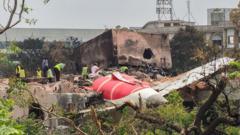

The agony for the families of those who perished in the Air India Flight AI171 crash near Ahmedabad airport on June 12, 2025, is being intensified by the wait for the recovery of all the bodies. The Boeing 787-8 Dreamliner, carrying 242 passengers and crew, crashed shortly after takeoff, striking a doctors' hostel and resulting in a massive fire. The process of identifying the deceased is proving to be painstakingly slow, prolonging the grieving process and leaving families in a state of limbo.
The crash has brought back painful memories of previous aviation disasters in India, including the Air India Express Flight IX-1344 crash in Kozhikode in 2020, where 21 lives were lost. In that incident, also involving an Air India Express flight, the aircraft overshot the tabletop runway during landing in heavy rain. The similarities between the two tragedies are unsettling, prompting renewed scrutiny of aviation safety standards and emergency response protocols.
The process of retrieving and identifying bodies from the wreckage is a complex and delicate operation. The intensity of the fire following the Ahmedabad crash has further complicated the efforts of the rescue teams. Forensic experts are working diligently to identify the remains, using methods such as DNA analysis, but the process is time-consuming and emotionally draining for everyone involved.
Families are desperate for closure, yearning to perform the last rites for their loved ones and begin the long journey of healing. However, the uncertainty surrounding the identification process is adding to their distress. Many are gathered near the crash site, anxiously awaiting news and seeking answers from authorities. The delay is not only a logistical challenge but also a deeply human one, testing the resilience and patience of those already grappling with unimaginable loss.
Air India has established an emergency center and support teams to assist the affected families, providing information and assistance. However, the most pressing need remains the swift and accurate identification of the victims. The airline and relevant authorities are under increasing pressure to expedite the process while ensuring that all necessary protocols are followed.
In the wake of the tragedy, there is a growing demand for a thorough investigation into the causes of the crash. Preliminary reports suggest a possible technical failure, but a comprehensive inquiry is essential to determine the exact sequence of events and identify any systemic issues that may have contributed to the disaster. The findings of the investigation will be crucial in preventing similar incidents in the future and ensuring the safety of air travel.
The recent tragedy serves as a stark reminder of the inherent risks associated with air travel and the importance of maintaining the highest standards of safety and vigilance. As the families of the victims continue to wait for the bodies of their loved ones, the nation mourns with them, hoping for closure and determined to learn from this devastating event. The wait deepens the pain, but it also strengthens the resolve to ensure that such tragedies are avoided in the future.